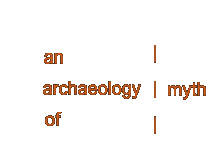
Myth returns us to the sacred, mythic roots of our profane stories. We are, so long as we tell stories, opening ourselves to the possibilities of myth.
 |
|
|
"God created men and women because he loves stories." --Elie Wiesel "We are storytelling animals. As our primitive ancestors sat around the fire carving spearheads and eating blackberries they told stories which in time were woven into a tapestry of myth and legend. These tales were the first encyclopedia of human knowledge. They explained where the world came from, why there were people, why snakes have no legs, why corn smut stops birth hemorrhages, why conch shells are sacred, why coyotes howl at night, and why the gods put fire and death on earth. In the dramatic telling the triumphs of heroes and the antics of fools came alive again. Stories told the people of a tribe who they were, where they had been, where they were going, and how to stay friendly with the spirits." [Sam Keen & Anne Valley-Fox, Your Mythic Journey: Finding Meaning in Your Life Through Writing and Storytelling 1 (Los Angeles: Jeremy P. Tarcher, 1989)] We use myth to bridge the safe stories we inherit and claim as our own with those stories we dread. We are, to ourselves, a host of stories: cover stories, fictions, rememberings, myths. A life is held together, gains coherence and form, through narrative plots and mythic motifs. The fiction of self is the story I weave as I live a narrative with its disjointed illogic of action, circumstance, experience, feeling, memory, and imagination. Stories embody the accidental and fragmentary; myth collects our story fragments within a larger enfolded structure that tugs on us from afar. Story-telling is a kind of myth-making. When we are telling, talking, tattling, teaching, we come close to myth; we become myth-makers. As we gain insight into our own stories we can see how one story embodies the stories of others, how our secular stories are wrapped around sacred stories, our personal stories are entangled in cultural narratives/media stories/institutional stories. Lawyers are story-tellers and story-makers and we might begin to see myth as one kind of story that we lawyers tell. Lawyers listen to the stories of clients, re-tell the stories to other lawyers, to judges, administrators, politicians; anyone who will listen and help the client. The law itself is composed of stories built around the Constitution, rules, old cases. In telling stories, being party to stories, and perpetrating the story of law, we constitute law and legal consciousness. A life is held together, gains coherence and form, through themes, plots, and myths that we embody in our lives. The themes and subplots for the life we live as adults are derived from the stories we have grown up with.These stories are always mediated by the stories we no longer tell; stories of the imaginal and archetypal figures left to us from myth. It is the mythic genre of legal narratives that would have us imagine law as the bulwark of order, tradition, and culture. Miraculously, and simultaneously, law is also the myth by which we free ourselves from the shackles of history and participate in the march of progress. In the shadow of these culture-bound mythic narratives, lawyers practice their craft, listen to the stories of their clients, refashion the stories they hear (or the ones they imagine they hear) to fit the language of the law and the law-culture story. Legal narratives of a mythic nature lend credence to the image and reality of the lawyer as a patron of justice. The myth of lawyer stories lies in advocacy that evokes a sense of justice and the claim that law speaks truth to power. The stories of lawyers also reveal the illusions and failures that accompany the myth of law. It is in our stories, particularly stories of failure, that we get a glimpse of the shadow side of professional life, and the unnamed, unattended pathologies associated with a life in law. Robert Cover used the image of law as a bridge from the reality
of the world as it now exists to an imagined world-that-might be. Law focuses our visions of the future. This image of law,
Cover argues, "is not a definition of law, but a plea to understand
law in a certain way." Bridges, like law, are traveled by way of
"sacred narratives," "learned and expressed through sacred
stories." The narratives of law, secular and sacred, have their mythic
qualities. "It is the canonical myths that supply purpose
for history. They are the stories we would write and would live if we
could." [Robert Cover, The Folktales of Justice:
Tales of Jurisdiction, 14 Cap. U.L. Rev. 179, 181 (1985)] |